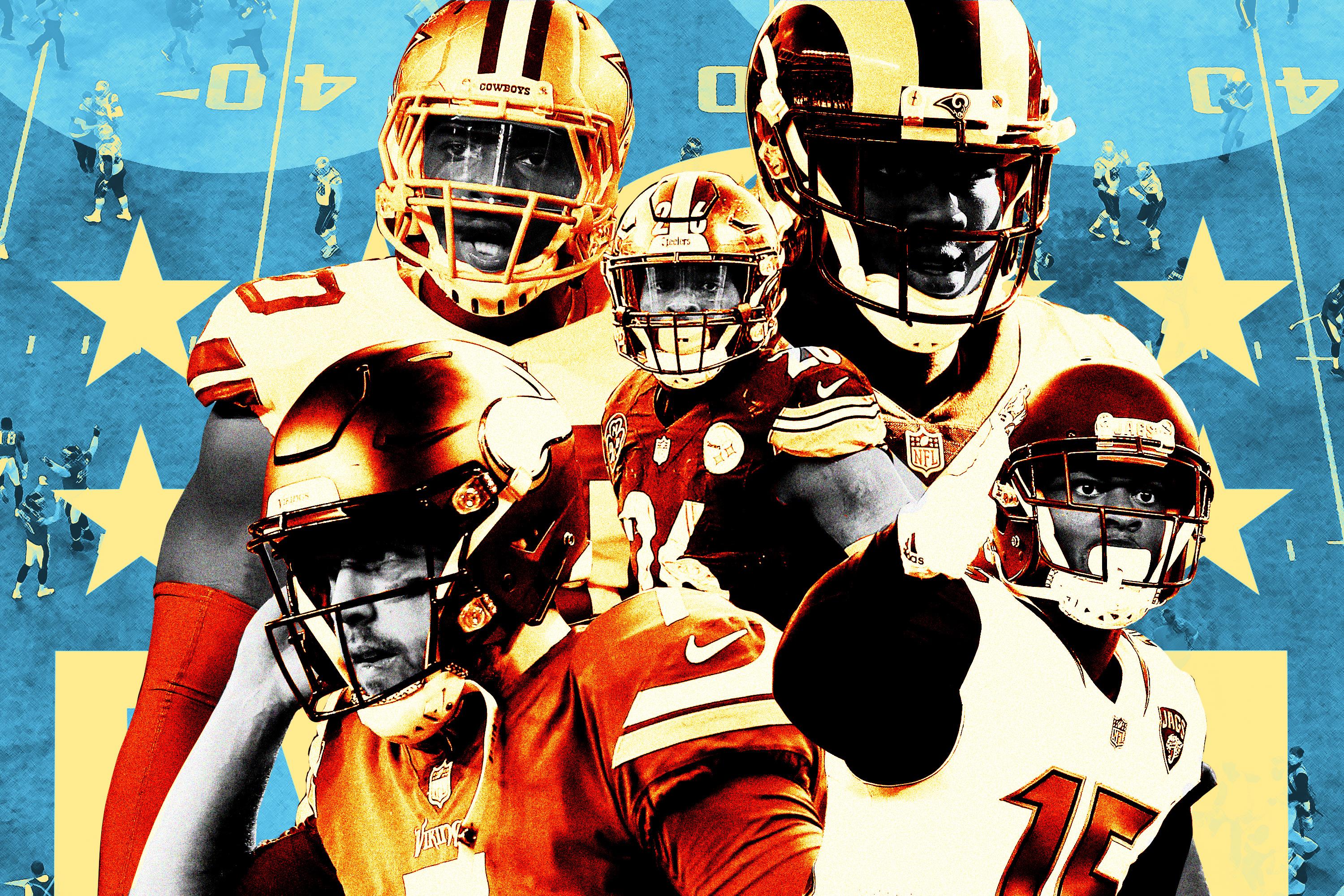
The NFL’s upcoming free-agency bonanza doesn’t officially kick off until March 14, but Tuesday marks the start of an important 15-day period in which teams can designate upcoming free agents with franchise-player or transition tags. The decisions teams make on which players to tag—or not—could have a big impact on how the free-agency dominoes fall once the new league year begins. With franchise-tag action close on the horizon, here’s a primer on the types of designations teams can use, plus a look at the players most likely to be tagged.
The Three Types of Tags
The Nonexclusive Tag
The nonexclusive franchise tag is the most commonly utilized of the three existing tags: it’s a one-year fixed-rate, guaranteed tender that prevents a player from hitting unrestricted free agency. Nonexclusive tag rates are calculated from the five-year average of the top-five salaries at each position and tied to a percentage of the cap (or 120 percent of the player’s previous salary, whichever is greater). While this year’s numbers haven’t yet been released, projections put the quarterback tag at about $23.6 million, defensive ends at about $17.4 million, corners at $15.2 million, receivers at $16.2 million, and running backs at $12 million.
A player under this tag is free to negotiate with other teams once free agency starts, but the original club has the right to match any offers made by another team. If the tagging team declines to match an offer, the offering team must surrender two first-round picks as compensation … which is why teams rarely make offers to franchise-tagged players. Obviously, the nonexclusive tag is reserved for big-impact players, as their guaranteed salaries count fully against the cap in that year, though often the tag is simply used as a placeholder to facilitate more extensive contract talks. This year, teams have until July 16 to negotiate multiyear deals with players they tag.
Five players were tagged under this designation last season: Arizona pass rusher Chandler Jones (who signed a five-year, $83 million extension a few weeks later), Giants pass rusher Jason Pierre-Paul (who signed for four years and $62 million a week after Jones), Panthers defensive tackle Kawann Short (who signed for five years and $80.5 million in April), Chargers pass rusher Melvin Ingram (who signed a four-year, $66 million deal in June), and Rams corner Trumaine Johnson, who was tagged for the second straight year (and never received a new deal).
The Exclusive Tag
The exclusive franchise tag, which prohibits the tendered free agent from negotiating with other teams at all, is used less frequently. Exclusive tag rates run slightly richer than their nonexclusive tag cousins, and are calculated by taking the average of the top-five salaries at the player’s position for the current year—not an average of the five previous years—or, again, 120 percent of the player’s previous salary, whichever is greater. Washington quarterback Kirk Cousins got the exclusive tag designation at this time last year, as did Steelers running back Le’Veon Bell, and pass rusher Von Miller got the exclusive tag from the Broncos back in 2016. This tag, in other words, is reserved solely for players who might actually be worth those two first-round picks to some teams.
The Transition Tag
Finally, don’t forget about the rarely used transition tag, which is similar to the nonexclusive tag except for two key areas. One, the salary rates for the transition tag are determined by taking the average of the top 10 players at each position (as opposed to the top five); and two, while tagging teams retain the right of first refusal should another team make that player an offer, they receive no compensation in the form of draft picks should they decide against matching that other team’s offer. The Dolphins placed the transition tag on pass rusher Olivier Vernon back in 2016, but then rescinded it after signing Mario Williams in free agency. Vernon ended up signing with the Giants as an unrestricted free agent.
Speaking of which, all three versions of the tag may be rescinded prior to being signed—the Panthers controversially took the tag off of Josh Norman two years ago, and he ended up leaving to sign in Washington—but once any tag is issued, whether it ends up rescinded or not, that team cannot utilize another.
On to this year’s tag candidates ...
The Players With a Chance to Get Tagged
Running Back Le’Veon Bell, Steelers
In early January, Bell hinted at a holdout, or even retirement, should the Steelers place the franchise tag on him for a second straight year, but the tag still feels like the most likely course of action for a team with the stated goal of keeping the star running back in Pittsburgh for his whole career. Of course, the Steelers could avoid the drama by coming to an agreement on a long-term extension with the 26-year-old playmaker—but that may not be easy or cheap. Bell turned down a multiyear contract offer last year that was said to average over $12 million per year and pay him $30 million in the first two years and $42 million in the first three. Instead, he chose to play last season under the $12.1 million franchise tag—and he recently said he wants to help reset the market at the running back position.
On one hand, the Steelers’ reticence thus far to dole out a big-money contract with major guarantees makes sense: Running backs take more punishment and tend to have shorter careers than just about every other position in the game. Plus, as we saw with the Eagles this year, teams are capable of fielding dynamic and talented running back platoons on the cheap. On the other hand, Bell’s no ordinary back; he’s a major focal point of not only the Steelers’ run game, but a crucial factor in the passing attack as well, capable of lining up anywhere on the field and running routes as a de facto receiver. So it makes sense that a player who’s caught 312 passes for over 2,600 yards in his career reportedly wants to be paid not just as a top running back, but as a no. 2 receiver, too.
Right now, the two top veteran running back contracts (for Devonta Freeman and LeSean McCoy) pay out at around $8 million average per year with over $18 million in guaranteed cash each. You can bet Bell will look to well outpace both of those numbers, especially considering another year on the franchise tag would cost the Steelers $14.5 million guaranteed alone (120 percent of what he made on the cap last year). As for that coveted no. 2 receiver money, Bell may point to deals for pass catchers like Emmanuel Sanders (who averages $11 million per year), Allen Hurns ($10 million per year), and Randall Cobb ($10 million per year) as starting points.
Defensive End DeMarcus Lawrence, Cowboys
Lawrence was one of the best edge rushers in the NFL in 2017, racking up 14.5 sacks (tied for second) while leading all 4-3 defensive ends with 79 pressures, per Pro Football Focus. But the 25-year old-comes with two back surgeries under his belt and has never come close to matching this year’s production before, with previous highs of eight sacks and 46 pressures in 2015.
The Cowboys must decide whether or not Lawrence’s 2017 performance was an outlier or the sign of things to come: If they think he’s going to continue to be one of the league’s most disruptive edge rushers, it makes sense to lock him up now, offering up a long-term deal similar to the five-year, $85 million contract the Giants gave Olivier Vernon or the five-year, $82.5 million deal the Cardinals gave to Chandler Jones. A multiyear contract like that would allow the team to spread out a big signing bonus over multiple years, easing the salary cap burden in 2018 for a team with just $19 million in change to work with. The safer route in the long term, though, could be to handing down the franchise tag, paying him the (projected) $17.4 million this year, and forcing him to prove that his career year was not a mirage before offering up a long-term extension.
Defensive End Ezekiel Ansah, Lions
When it comes to offering Ansah a long-term, big-money contract extension, new Lions head coach Matt Patricia must answer two questions. One, how is this guy going to fit in the team’s new scheme? And two, which version of the player will the Lions be getting in 2018: the one that racked up 14.5 sacks in 2015 and another 12 sacks in 2017, or the guy who fought through an ankle injury and registered just two sacks in 2016? Neither question is easy to answer—and that’s why a “prove it” year with the franchise tag might be in the team’s best interests. Going that route would cost the team about $17.4 million against the cap, but Detroit has $44.7 million in space heading into free agency, giving them more than enough wiggle room.
Quarterback Case Keenum, Vikings
Keenum went from an afterthought backup-quarterback signing in free agency last spring to the team’s dynamic starter in the fall, replacing an injured Sam Bradford in Week 2 before throwing 22 touchdowns and just seven picks while leading the Vikings to the NFC championship game. There aren’t many quarterbacks that break out in the NFL in their age-29 season—reason enough to fear a major regression next year—and when you add in the fact Minnesota offensive coordinator and renowned QB whisperer Pat Shurmur left to take the head-coaching job with the Giants, handing Keenum a long-term lucrative deal looks pretty risky from the team’s point of view.
That’s why the Vikings could go the franchise-tag route, eating a $23 million cap charge this year to force their surprising starter to prove he’s the real deal before they commit to him for the long run. With $49 million and change in cap space, Minnesota can afford it.
Wide Receiver Allen Robinson, Jaguars
Robinson’s best year came in 2015, when he caught 80 passes for 1,400 yards, tying for the league high with 14 touchdowns. He regressed in 2016, however, catching 73 passes for 883 yards and six scores, and then missed nearly all of 2017 with a torn ACL. Jacksonville’s reportedly not willing to shell out a long-term deal—the Jags would prefer to sign him to a one-year contract and have him prove that his knee injury won’t be a lasting concern. But Robinson’s going to be looking for security, and while the past two years may hurt his leverage, there’s bound to be a few teams that look at what he did in 2015 (catching passes from Blake Bortles, no less) and think he’s a true no. 1 threat who’s worth the big bucks.
That means that if the Jags want to keep Robinson, they may be forced to tag the 24-year-old playmaker and pay him the estimated $16.2 million in 2018. That would make Jacksonville’s cap situation (about $16.9 million in room) pretty damn tight—especially if the team can’t dump Bortles and his $19 million cap number next year as he recovers from wrist surgery.
Guard Andrew Norwell, Panthers
Norwell’s slated to become the top free-agent guard in this class, and on the open market, the 2017 All-Pro could fetch something close to the five-year, $60 million deal Kevin Zeitler signed last year. Tagging Norwell carries risk: Carolina may be hesitant to allocate another $14.2 million (the franchise-tag salary) to an offensive line position group that’s already set to take up over $28 million in cap space next year, with a combined $24.1 million of that dedicated to the trio of Ryan Kalil, Matt Kalil, and Trai Turner. With just over $20 million in cap space heading into the offseason, the team wouldn’t be left with a lot of room to improve other areas on the roster.
Still, the Panthers seem likely to use the tag as a placeholder, with the goal of completing a long-term deal for Norwell before the July 16 deadline. In order to free up some cap space and avoid dedicating so much of their cap to the offensive line, the team could end up cutting the elder Kalil (Ryan), who’s missed 18 games over the past two years.
Defensive Tackle Sheldon Richardson and Tight End Jimmy Graham, Seahawks
Graham finally emerged as the team’s unstoppable red zone target in 2017, leading all tight ends with 10 touchdowns. But his numbers and effectiveness fell off a cliff almost everywhere else on the field as he averaged a career-low 9.1 yards per catch, and a combination of his age (he’ll turn 32 next season) and injury history (particularly his patellar tendon tear) could make Seattle hesitant to offer anything long-term. It may come down to how much value the Seahawks place on having such a potent touchdown-maker inside the 10-yard line, an area of the field in which they’ve struggled mightily under Pete Carroll (and I’m not just talking about that infamous Super Bowl XLIX interception). Is that goal-line trump card worth the $10 million Graham would earn on the tag?
It’s tough to say whether it makes sense for Seattle to tag Richardson, either. On one hand, it’d be nice for the Seahawks to hold on to the player for whom they spent a second-round pick (and receiver Jermaine Kearse) to acquire last August. But on the other hand, Richardson never really made the type of impact the team hoped for last year: He was excellent against the run, but the 6-foot-3 295-pounder grabbed just one sack and finished with 36 pressures, ninth among interior linemen—and it’s hard to rationalize shelling out $14 million-plus (the cost to tag a defensive tackle) to a defensive lineman who’s not getting sacks. Unless, of course, they think he’s going to significantly improve on those numbers in 2018.
Cornerback Kyle Fuller, Bears
Fuller sat out the 2016 season with a knee injury, but the former first-rounder bounced back with a breakout campaign in 2017, recording two picks and 22 passes defensed (tied for third most) for the Bears. With $41 million and change in cap space heading into free agency, Chicago could easily afford the $17.4 million cap charge a franchise tag would cost it this year, and it’d give the team a chance to see if Fuller can recreate anything close to his performance this past year. In a division with Aaron Rodgers, Matt Stafford, and possibly Keenum, Chicago needs all the help it can get at the cornerback position—so hanging on to the 26-year-old, even if it’s just for one season, should be a big priority.
Wide Receiver Jarvis Landry, Dolphins
Landry’s posted incredible numbers in his four-year career, averaging 100 catches for 1,010 yards and six touchdowns per season. But he operates primarily out of the slot (where he ran 65 percent of his routes in 2017) and averages just 10.1 yards per reception, neither of which is a typical characteristic of pass catchers who fetch top dollar at the position (insert joke about Tavon Austin here). With the receiver franchise-tag number set to hit $16.2 million in 2018, the Dolphins would be paying a big premium for a guy who hasn’t proved to be much of a deep threat and who has yet to score double-digit touchdowns in a single season.
Then again, Landry is highly effective in the short and intermediate passing game, is highly elusive after the catch, and the team doesn’t really have many reliable playmakers behind him.
Wide Receiver Sammy Watkins and Safety Lamarcus Joyner, Rams
Watkins is talented, no doubt, and his upside is through the roof. But it’s hard to ignore the fact he was essentially the team’s third option in the passing game in 2017, behind Robert Woods and Cooper Kupp (or fourth, if you count Todd Gurley)—and there aren’t many teams paying no. 3 receivers $16.2 million a year (the cost of the receiver tag). Then again, L.A. gave up a quality corner in E.J. Gaines and a 2018 second-round pick to acquire Watkins from the Bills, and an entire offseason mastering the team’s playbook and gaining chemistry with quarterback Jared Goff could pay huge dividends. It’s hard to predict what the Rams will do here, but it seems like they’d be better off attempting to sign Watkins to an extension while using the tag on a bigger need: the defensive secondary.
With cornerback Trumaine Johnson, nickelback Nickell Robey-Coleman, and safety Lamarcus Joyner all set to hit free agency in March, the Rams may decide the tag is best used on Joyner, who broke out in 2017 under defensive coordinator Wade Phillips. Franchise-tagging Joyner would count $11.4 million against the cap, an acceptable range for a team with $40.5 million in cap space and facing the loss of three starters in the secondary.

